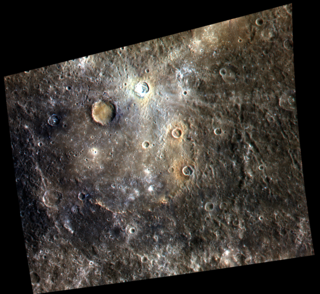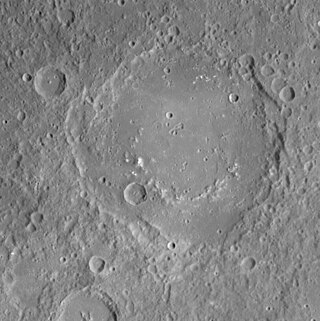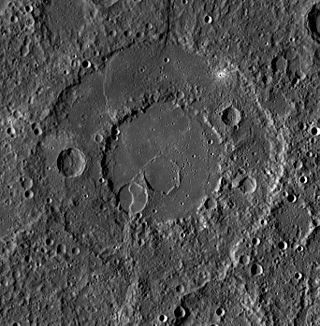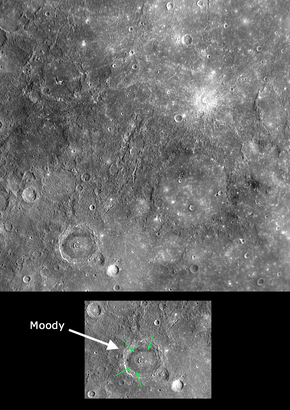
Caloris Planitia is a plain within a large impact basin on Mercury, informally named Caloris, about 1,550 km (960 mi) in diameter. It is one of the largest impact basins in the Solar System. "Calor" is Latin for "heat" and the basin is so-named because the Sun is almost directly overhead every second time Mercury passes perihelion. The crater, discovered in 1974, is surrounded by the Caloris Montes, a ring of mountains approximately 2 km (1.2 mi) tall.

Degas is a rayed crater on Mercury at latitude 37.5 N, longitude 127 W. Its diameter is 54 kilometres (34 mi). It was named after the French impressionist painter Edgar Degas in 1979. The rays consist of light colored material blasted out during the crater's formation. Craters older than Degas are covered by the ray material, while younger craters are seen superimposed on the rays. Degas forms a crater pair with Brontë to the north. Both lie near the center of Sobkou Planitia.

Vivaldi is a crater on Mercury. It was named by the IAU after Italian composer Antonio Vivaldi in 1976. It has a prominent and nearly continuous inner ring whose diameter measures about half that of the outer ring. It is one of 110 peak ring basins on Mercury. Unlike some of the lunar multiringed structures, no vestiges of additional rings are apparent around this crater. It is classified as c3 age.

Mozart is a crater on Mercury, named by the IAU in 1976 after Austrian composer Wolfgang Amadeus Mozart.

Homer is a crater on Mercury. It is one of 110 peak ring basins on Mercury.

Eminescu is a peak ring crater on Mercury 125 kilometers (78 mi) in diameter. Since there are very few later craters superposed on it, Eminescu appears to be a young crater formed around one billion years ago. It has a transitional morphology between larger more complex impact basins like Raditladi and smaller simpler central peak craters.

Praxiteles is a crater on Mercury. It is one of 110 peak ring basins on Mercury.

Amaral is a crater on the planet Mercury. With its smooth floor, surrounding ejecta, and small secondary craters, it appears noticeably younger than the heavily cratered surface around it. Along with a smooth crater floor, Amaral also has a central peak. Bright material on this peak is of particular interest as it appears to have an unusual color. In color-enhanced images, the central peak of Amaral appears as a bright blue color in striking contrast to the otherwise orange tones of surface material nearby. The different color of the central peak likely indicates rocks with different chemical composition from those on the neighboring surface.

Raditladi is a large impact crater on Mercury with a diameter of 263 km. Inside its peak ring there is a system of concentric extensional troughs (graben), which are rare surface features on Mercury. The floor of Raditladi is partially covered by relatively light smooth plains, which are thought to be a product of the effusive volcanism. The troughs may also have resulted from volcanic processes under the floor of Raditladi. The basin is relatively young, probably younger than one billion years, with only a few small impact craters on its floor and with well-preserved basin walls and peak-ring structure. It is one of 110 peak ring basins on Mercury.

Izquierdo is a crater on Mercury. Its name was adopted by the International Astronomical Union (IAU) in 2009, for the Mexican painter María Izquierdo. The floor of Izquierdo is smooth, the result of having been partially filled with volcanic lava. Circular outlines of the rims of “ghost craters” – smaller, older craters that have been largely buried by the lavas that infilled the basin – are visible in a few places on Izquierdo's floor. The remnants of a buried inner ring are also barely discernible in spots, and it is one of 110 peak ring basins on Mercury. There have been more recent impacts into the floor of Izquierdo, resulting in some small, sharply defined craters.

Scarlatti is a pit-floored crater on Mercury, which was discovered in 1974 by the Mariner 10 spacecraft. It has a prominent peak ring, and it is one of 110 peak ring basins on Mercury. The crater floor is covered by the smooth plains material. The crater displays an arcuate collapse feature along the northeastern peak ring. The size of the pit, which was first noticed in MESSENGER images obtained in January 2008, is 38 × 12 km. Such a feature may have resulted from collapse of a magma chamber underlying the central peak ring complex of the crater. The collapse feature is an analog of Earth's volcanic calderas. Scarlatti is thought to have the same age as the Caloris basin.

Rachmaninoff is an impact crater on Mercury. This basin, first imaged in its entirety during MESSENGER's third Mercury flyby, was quickly identified as a feature of high scientific interest, because of its fresh appearance, its distinctively colored interior plains, and the extensional troughs on its floor. The morphology of Rachmaninoff is similar to that of Raditladi, which is one of the youngest impact basins on Mercury. The age of Raditladi is estimated at one billion years. Rachmaninoff appears to be only slightly older.

Derain is a crater on Mercury named after André Derain, a French artist, painter, sculptor and co-founder of Fauvism with Henri Matisse. It has uncommonly dark material within and surrounding the crater. The material is darker than the neighboring terrain such that this crater is easily identified even in a distant global image of Mercury. The dark halo may be material with a mineralogical composition different from the majority of Mercury's visible surface. Craters with similar dark material on or near their rims were seen on the floor of the Caloris basin during MESSENGER’s first flyby.

Al-Hamadhani is a crater on Mercury. It has a diameter of 186 kilometers. Its name was adopted by the International Astronomical Union in 1979. Al-Hamadhani is named for the Iranian writer Badi' al-Zaman al-Hamadani, who died in 1007 C.E.

Bartók is a crater on Mercury. Its name was adopted by the International Astronomical Union (IAU) in 1979. Bartók is named for the Hungarian composer Béla Bartók, who lived from 1881 to 1945.

Dürer is a crater on Mercury. It has a diameter of 195 kilometers. Its name was adopted by the International Astronomical Union (IAU) in 1976. Durer is named for the German artist Albrecht Dürer, who lived from 1471 to 1528.

Renoir is a crater on the planet Mercury. Its name, after the French painter Pierre-Auguste Renoir (1841–1919), was adopted by the International Astronomical Union in 1976.

Holst is a crater on Mercury. Its name was adopted by the International Astronomical Union (IAU) on April 24, 2012.

Alver is a crater on Mercury. It has a diameter of 151.49 kilometers. Its name was adopted by the International Astronomical Union (IAU) on March 15, 2013. Alver is named for the Estonian poet Betti Alver.
Hollows are a landform on the planet Mercury, discovered during the MESSENGER mission that orbited the planet from 2011 to 2015.






















